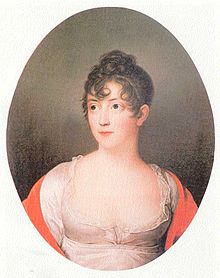- Christian VIII of Denmark
-
"Christian Frederick" redirects here. For other uses, see Christian Frederick (disambiguation).
Christian VIII 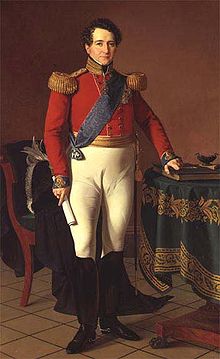
King of Denmark Reign 1839–1848 Predecessor Frederick VI Successor Frederick VII King of Norway Reign 1814 Predecessor Frederick VI Successor Charles II Consort Charlotte Frederica of Mecklenburg-Schwerin
Caroline Amalie of Schleswig-Holstein-Sonderborg-AugustenburgIssue Frederick VII of Denmark Full name Christian Frederick House Oldenburg Father Frederick, Hereditary Prince of Denmark Mother Sophia Frederica of Mecklenburg-Schwerin Born 18 September 1786
Christiansborg Palace, CopenhagenDied 20 January 1848 (aged 61)
Amalienborg Palace, CopenhagenBurial Roskilde Cathedral Religion Lutheranism Danish Royalty House of Oldenburg
Main Line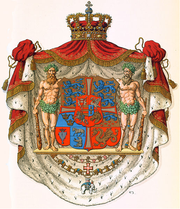
Christian VIII Children Prince Christian Frederick Frederick VII Christian VIII (Christian Frederik) (18 September 1786 – 20 January 1848), king of Denmark 1839–48 and, as Christian Frederick, of Norway 1814, eldest son of Hereditary Prince Frederick of Denmark and Norway and Sophia Frederica of Mecklenburg-Schwerin, was born in 1786 at Christiansborg Palace in Copenhagen. His paternal grandparents were the late king Frederick V of Denmark and his second wife Juliana Maria of Brunswick-Wolfenbüttel.
He inherited the talents of his highly gifted mother, and his amiability and handsome features are said to have made him very popular in Copenhagen.
Contents
First marriage
His unfortunate first marriage at Ludwigslust on 21 June 1806 with his cousin Charlotte Frederica of Mecklenburg-Schwerin (Ludwigslust, 4 December 1784 – Rome, 13 July 1840) was dissolved by divorce in 1810. She was a daughter of Friedrich Franz I, Grand Duke of Mecklenburg-Schwerin and Princess Louise of Saxe-Gotha-Altenburg. His only surviving son from this marriage would become Frederick VII of Denmark. His first born son was Christian Frederik, who was born and died at Schloss Plön on 8 April 1807.
King of Norway
In May 1813, being the then heir presumptive of Denmark-Norway, he was sent as stattholder (the Danish King's highest representative in overseas territories) to Norway to promote the loyalty of the Norwegians to the dynasty, which had been very rudely shaken by the disastrous results of Frederick VI's adhesion to the falling fortunes of Napoleon I of France. He did all he could personally to strengthen the bonds between the Norwegians and the royal house of Denmark. Though his endeavours were opposed by the so-called Swedish party, which desired a dynastic union with Sweden, he placed himself at the head of the Norwegian party of independence after the Treaty of Kiel had forced the king to cede Norway to the king of Sweden. He was elected Regent of Norway by an assembly of notables on 16 February 1814.
See article on Norway in 1814
This election was confirmed by the Norwegian Constituent Assembly convoked at Eidsvoll on 10 April, and on 17 May the constitution was signed and Christian was unanimously elected king of Norway, under the name Christian Frederick.
Christian next attempted to interest the great powers in Norway's cause, but without success. On being pressed by the commissioners of the allied powers to bring about a union between Norway and Sweden in accordance with the terms of the treaty of Kiel, and then return to Denmark, he replied that, as a constitutional king, he could do nothing without the consent of the parliament (Storting), which would not be convoked until a suspension of hostilities on the part of Sweden.
Sweden refused Christian's conditions and a short campaign ensued, in which the Norwegian army was defeated by the forces of the Swedish crown prince Charles John. The brief war was finally concluded by the Convention of Moss on 14 August 1814. According to this treaty, king Christian Frederick transferred the executive power to the Storting, and then abdicated and returned to Denmark. The Storting in its turn adopted the constitutional amendments necessary to allow for a personal union with Sweden, and on 4 November elected Charles XIII of Sweden as the new king of Norway.
King of Denmark
Henceforth Christian's suspected democratic principles made him persona ingratissima at all the reactionary European courts, his own court included. He and his second wife, Princess Caroline Amalie of Schleswig-Holstein-Sonderburg-Augustenburg (Copenhagen, 28 June 1796 - Amalienborg Palace, 9 March 1881) (daughter of Louise Augusta of Denmark, only sister of Frederick VI), whom he married at Augustenborg Palace on 22 May 1815, by whom he had no issue, lived in comparative retirement as leaders of the literary and scientific society of Copenhagen. She was the 290th Dame of the Royal Order of Queen Maria Luisa on 16 February 1834.
It was not until 1831 that old King Frederick gave him a seat in the council of state. On 13 December 1839 he ascended the Danish throne as Christian VIII. The Liberal party had high hopes of “the giver of constitutions,” but he disappointed his admirers by steadily rejecting every Liberal project. Administrative reform was the only reform he would promise. In his attitude to the growing national unrest in the twin-duchies he often seemed hesitating and half-hearted which damaged his position, and not until 1846 did he clearly support the idea of Schleswig being a Danish area.
Some historians and biographers believe, however, that king Christian would have given Denmark a free constitution had he lived long enough, and his last words are sometimes (rather tragically) recorded as "I didn't make it". ("Jeg nåede det ikke.")
King Christian VIII continued his predecessor's patronage of astronomy, awarding gold medals for the discovery of comets by telescope, and financially supporting Heinrich Christian Schumacher with his publication of the scientific journal Astronomische Nachrichten.
Seeing that his only legitimate son, the future Frederick VII, was apparently unable to beget heirs, he commenced arrangements to secure the succession in Denmark, which led to the future Christian IX being chosen as a hereditary prince, officially by a new law enacted on 31 July 1853, after an international treaty made in London.
He was the 960th Knight of the Order of the Golden Fleece in Spain in 1840.
He died of blood poisoning in Amalienborg Palace in 1848 and was interred in Roskilde Cathedral.
Legacy
He had ten children outside marriage. He carefully listed them and saw that they were treated well.
After his son Frederick VII died in 1863, his first cousin once removed, Christian IX of Denmark, ascended the throne of Denmark.
In 1905, 57 years after his demise, and 91 years after his struggle in support of independence and his own brief kingship in Norway, his great-grandnephew Prince Carl of Denmark was chosen to become the first king of independent Norway, and took the name Haakon VII of Norway.
Ancestry
References
 This article incorporates text from a publication now in the public domain: Chisholm, Hugh, ed (1911). Encyclopædia Britannica (11th ed.). Cambridge University Press.
This article incorporates text from a publication now in the public domain: Chisholm, Hugh, ed (1911). Encyclopædia Britannica (11th ed.). Cambridge University Press.
Obituary (astronomy)
Christian VIIIBorn: 18 September 1786 Died: 20 January 1848Regnal titles Preceded by
Frederick VIKing of Norway
1814Succeeded by
Charles IIKing of Denmark
Duke of Schleswig, Holstein
and Saxe-Lauenburg
1839–1848Succeeded by
Frederick VIIDanish princes The generations are numbered from the ascension of Christian I as King of Denmark in 1448. 1st generation 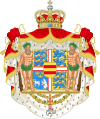
2nd generation Prince John · Prince Ernest · Christian II · Prince Francis · Christian III · Prince John, Duke of Holstein-Haderslev · Prince Adolf, Duke of Holstein-Gottorp · Prince Friedrich, Bishop of Hildesheim and Schleswig3rd generation Prince John · Prince Philip Ferdinand · Prince Maximilian · Frederick II · Magnus of Livonia · Prince John, Duke of Holstein-Sonderburg4th generation 5th generation 6th generation 7th generation Frederick IV · Prince Christian William · Prince Christian · Prince Charles · Prince William · Prince William, Duke of Gloucester · Prince George · Prince Charles8th generation Prince Christian · Christian VI · Prince Frederik Charles · Prince George · Prince Frederik Christian · Prince Charles9th generation 10th generation Prince Christian · Christian VII · Frederick, Hereditary Prince11th generation 12th generation Prince Christian · Prince Christian · Frederick VII13th generation 14th generation Christian X · Haakon VII of Norway · Prince Harald · Constantine I of Greece* · Prince George* · Prince Nicholas* · Prince Andrew* · Prince Christopher* · Prince Gustav · Prince Aage** · Prince Axel · Prince Erik** · Prince Viggo**15th generation Frederick IX · Prince Knud · Prince Gorm · Prince Oluf** · George II of Greece* · Alexander of Greece* · Paul of Greece* · Philip, Duke of Edinburgh* · Prince Michael* · Prince Peter* · Prince George Valdemar · Prince Flemming Valdemar**16th generation 17th generation Crown Prince Frederik · Prince Joachim · Pavlos, Crown Prince of Greece* · Prince Nikolaos* · Prince Philippos*18th generation Prince Nikolai · Prince Felix · Prince Christian · Prince Henrik · Prince Vincent · Prince Constantine-Alexios* · Prince Achileas-Andreas* · Prince Odysseas-Kimon* · Prince Aristide-Stavros* ·*also a prince of Greece
**lost his title due to an unequal marriage
***not a Danish prince by birth, but a royal prince consortMonarchs of Denmark Early monarchs c.916–1412(Harthacnut) · Gorm the Old · Harald Bluetooth · Sweyn Forkbeard1 · Harald II · Cnut the Great1 · Harthacanute1 · Magnus the Good · Sweyn II · Harald III · Canute the Saint · Olaf I · Eric Evergood · Niels · Eric the Memorable · Eric Lamb · Sweyn Grathe / Canute V / Valdemar the Great · Canute VI · Valdemar the Victorious / Valdemar the Young · Eric Plough-tax · Abel · Christopher I · Eric Klipping · Eric Menved · Christopher II · Valdemar III · Christopher II · Interregnum · Valdemar Atterdag · Olaf II · Margaret I2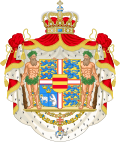
Palatinate-Neumarkt 1397–1448Oldenburg 1448–1863Christian I2 · John2 · Christian II2 · Frederick I · Christian III · Frederick II · Christian IV · Frederick III · Christian V · Frederick IV · Christian VI · Frederick V · Christian VII · Frederick VI · Christian VIII · Frederick VIISchleswig-Holstein-
Sonderburg-Glücksburgsince 1863Italics indicates Danish monarchs who were also monarchs of Norway.
1 Also monarch of England. 2 Also monarch of Sweden. 3 Also monarch of Iceland.Monarchs of Norway Fairhair dynasty · rival
rulers of other housesHarald I Fairhair · Eric Bloodaxe · Haakon I the Good · Harald II Greycloak · Haakon Sigurdsson 1 · Olaf I Tryggvason · Eiríkr Hákonarson 1 & Sveinn Hákonarson 1 & Hákon Eiríksson 1 · Sweyn Forkbeard · Olaf II the Saint · Hákon Eiríksson 1 · Canute the Great · Sveinn Álfífuson 1 · Magnus I the Good · Harald III Hardrada · Magnus II Haraldsson · Olaf III Kyrre · Haakon Magnusson & Magnus III Barefoot · Olaf Magnusson · Eystein I Magnusson · Sigurd I the Crusader · Magnus IV the Blind · Harald IV Gille · Sigurd the Noisy · Sigurd II Munn · Eystein II Haraldsson · Inge I Haraldsson the Hunchback · Haakon II Broadshoulder · Magnus Erlingsson · Sigurd Markusfostre · Olav the Unlucky · Eystein the Maiden · Sverre Sigurdsson · Jon Kuvlung · Sigurd Magnusson · Inge Magnusson · Haakon III Sverresson · Guttorm Sigurdsson · Inge II Bårdsson · Erling Stonewall · Philip Simonsson · Haakon IV Haakonsson · Haakon the Young · Magnus VI the Law-mender · Eric II Magnusson · Haakon V MagnussonKnýtlinga 985–995
1028–1035Fairhair dynasty · Sweyn Forkbeard 5 · Fairhair dynasty · Canute the Great 5 · Sweyn Knutsson 2 Fairhair dynastyBjelbo 1319–1387The Kalmar union 1387–1448Oldenburg 1448–1814Christian I 4 · John 4 · Christian II 4 · Frederick I 2 · Christian III 2 · Frederick II 2 · Christian IV 2 · Frederick III 2 · Christian V 2 · Frederick IV 2 · Christian VI 2 · Frederick V 2 · Christian VII 2 · Frederick VI 2 · Christian FrederickHolstein-Gottorp
Bernadotte1814–1905Schleswig-Holstein-
Sonderburg-Glücksburgsince 19051 Regent. 2 Also Danish monarch. 3 Also Swedish monarch. 4 Also Danish and Swedish monarch.5 Also Danish and English monarch. External links
Categories:- 1786 births
- 1848 deaths
- People from Copenhagen
- Danish monarchs
- Dukes of Saxe-Lauenburg
- Dukes of Schleswig
- Dukes of Holstein
- House of Oldenburg
- Regents
- Protestant monarchs
- Knights of the Golden Fleece
- Royal Fellows of the Royal Society
- Burials at Roskilde Cathedral
- Governors-general of Norway
- 19th-century monarchs in Europe
- Grand Commanders of the Order of the Dannebrog
Wikimedia Foundation. 2010.

